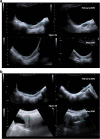Increased incidence of precocious and accelerated puberty in females during and after the Italian lockdown for the coronavirus 2019 (COVID-19) pandemic
- PMID: 33148304
- PMCID: PMC7609833
- DOI: 10.1186/s13052-020-00931-3
Increased incidence of precocious and accelerated puberty in females during and after the Italian lockdown for the coronavirus 2019 (COVID-19) pandemic
Abstract
Background: The timing of puberty in girls is occurring at an increasingly early age. While a positive family history is recognised as a predisposing factor for early or precocious puberty, the role of environmental factors is not fully understood.
Aims of the study: To make a retrospective evaluation of the incidence of newly diagnosed central precocious puberty (CPP) and the rate of pubertal progression in previously diagnosed patients during and after the Italian lockdown for COVID-19, comparing data with corresponding data from the previous 5 years. To determine whether body mass index (BMI) and the use of electronic devices increased during lockdown in these patients.
Patients and methods: The study included 49 females with CPP. We divided the patients into two groups: group 1, patients presenting a newly diagnosed CPP and group 2, patients with previously diagnosed slow progression CPP whose pubertal progression accelerated during or after lockdown. We collected auxological, clinical, endocrinological and radiological data which were compared with data from two corresponding control groups (patients followed by our Unit, March to July 2015-2019). Patients' families completed a questionnaire to assess differences in the use of electronic devices before and during lockdown.
Results: Thirty-seven patients presented newly diagnosed CPP (group 1) and 12, with previously diagnosed but untreated slow progression CPP presented an acceleration in the rate of pubertal progression (group 2). The number of new CPP diagnoses was significantly higher than the mean for the same period of the previous 5 years (p < 0.0005). There were no significant differences between patients in group 1 and control group 1 regarding time between appearance of B2 and CPP diagnosis, although group 1 patients had a significantly earlier chronological age at B2, a more advanced Tanner stage at diagnosis (p < 0.005), higher basal LH and E2 levels, higher LH peak after LHRH test (p < 0.05) and increased uterine length (p < 0.005) and ovarian volume (p < 0.0005). The number of patients with previously diagnosed CPP whose pubertal development accelerated was also statistically higher compared to controls (p < 0.0005). In this group, patients' basal LH (p < 0.05) and E2 levels (p < 0.0005) became more markedly elevated as did the LH peak after LHRH test (p < 0.05). These patients also showed a significantly accelerated progression rate as measured by the Tanner scale (p < 0.0005), uterine length (p < 0.005), and ovarian volume (p < 0.0005). In both group 1 and group 2, BMI increased significantly (p < 0.05) and patients' families reported an increased use of electronic devices (p < 0.0005).
Conclusion: Our data show an increased incidence of newly diagnosed CPP and a faster rate of pubertal progression in patients with a previous diagnosis, during and after lockdown compared to previous years. We hypothesize that triggering environmental factors, such as the BMI and the use of electronic devices, were enhanced during lockdown, stressing their possible role in triggering/influencing puberty and its progression. However, more studies are needed to determine which factors were involved and how they interacted.
Keywords: Accelerated puberty; COVID-19; Precocious puberty.
Conflict of interest statement
The authors have no conflicts of interest to declare.
Figures


References
-
- Herman-Giddens ME, Slora EJ, Wasserman RC, Bourdony CJ, Bhapkar MV, Koch GG, Hasemeier CM. Secondary sexual characteristics and menses in young girls seen in office practice: a study from the pediatric research in office settings network. Pediatrics. 1997;99(4):505–512. doi: 10.1542/peds.99.4.505. - DOI - PubMed
MeSH terms
LinkOut - more resources
Full Text Sources
Medical
Research Materials

